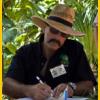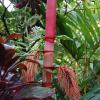For those of you who are interested in Jubaeas, go to Travel Logs and check out the attachment that Bruno posted of Jubaeas in habitat in Chile. These are the best photos that I have seen of Jubaeas in habitat. Credit must go where credit is due, and the pictures were taken by Brandt Maxwell from the French palm site, Fous de Palmiers.
Several things strike me. I'm surprised that not only do the palms grow in the valleys where it might be expected to be more moist, but also on the mountain tops where it must be much dryer. From the xerophilous plants growing around the Jubaeas, it must be an area where long periods of drought can be expected. I also noticed the blacken evidence of fire at the base of some of the palms. Also, quite remarkable, in most habitat photos of palms, you will see some that have died and only a trunk remaining. I see no dead palms in any of these photos.
The palms growing at La Campana have very graceful fronds hanging down below 90 degrees from the trunks and in one photograph they seem to be the silver variety. I have 4 mature Jubaeas and one has a very strict growth habit, while the others are less so, but none of the fronds hang below 90 degrees from the trunk. All of mine are green and the fronds are very rigid and tough. I've experienced 60 mph winds and none of mine have ever had any wind damage. Mine get watered 12 months of the year, so I wonder if the rigid fronds on mine are enviromental or genetic? I suspect genetic, as the plants probably came from the same tree. It's been so long ago I can't remember where my Jubaeas came from, but I suspect from one of the few old trees growing in the Bay Area.
I expect the trees growing at La Campana got a good shake in the recent earthquake in Chile but they have withstood many before as they must be ancient.
Dick


